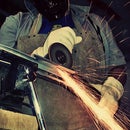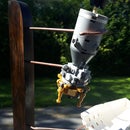Introduction: Bellows Bee Smoker for the Home Apiarist
It's always been a dream, of mine, to have a few bee hives, so when I found a swarm on my property, I was pretty elated. More than that, they were free, they were wild and they were plentiful. I realized that it presented an opportunity to create my apiary in a traditional way, from building my hives, to creating my own equipment from scratch.
Unfortunately, the site I'd secured, on a neighboring farm property fell through, and I was left with 50,000 bees without a home. Luckily, it's not to difficult to find a home for wayward bees, and within a few days they were settled in a nice apiary in the next town.
Now there's no shortage of beehive plans online and I really don't have anything new to offer in that regard, however, I did notice that there was very little, in the way, of plans for building a bellows smoker. As it was one of the first (and favorite) items I created, I thought I'd share it with the instructables community.
A smoker works by pumping air into a metal canister, via the use of bellows, and forcing the smoke from burning twigs and leaves in a controlled direction. The action of 'smoking' a hive causes an instinctive reaction, in the bees, whereby their natural tendency is to gorge themselves on honey, to the point of lethargy as a defense against forest fires. This makes the bees docile enough to handle, minimizing stinging and aggression.
This design is based on the original design, created by Moses Quimby in the 19th century and remains the standard in bee smokers to this day.
Step 1: Tools and Supplies
Tools;
- hack saw/tin snips or wheel cutter
- hammer and anvil
- bolt or strong wire cutters
- sharp knife
- drill with bits
- step drill bit
Supplies;
- stainless steel toilet bowl brush holder (dollar store)
- 3-4oz leather patch
- tack nails
- brass sheet or copper pipe with fittings
- empty candy tin
- large spring
- two 3.5x6x.25" pine boards
- copper rivets or small nuts and bolts
- self tapping screws
- artist canvas/leather or other dense material
Step 2: Making the Burner Chamber
First you need to disassemble the toilet brush canister and remove any plastic. You should be left with a hollow stainless steel tube. Use your saw/tin snips or wheel cutter to cut it down to between 7-8" long. Once your tube has been cut to size, you'll need to create a base with the candy tin. I was fortunate enough that the inner diameter of the tin and the outer diameter of the canister were the same size, however you may have to experiment with finding a metal object that fits properly. Once you've fitted your base, use some self tapping metal screws to secure it into place.
Don't worry about burning the finish from the tin. The first time you burn material in your smoker should take care of that. Just be sure not to breathe it in or subject your bees to the smoke until its completely gone.
You'll need to elevate the material in the canister to allow air underneath so that it burns more evenly. You can achieve this with some expanded metal, cut into a round shape and bent down at the edges. I secured mine by drilling a hole in the base and bolting it down, but it isn't necessary. It will, however, help when you need to empty your smoker, not having to deal with a hot metal base falling out on you.
Step 3: Creating Your Outlet Lid
For mine, I created the outlet out of a sheet of brass, but any other metal sheet will work. I simply cut it into a funnel shape, and hammered it to size around the horn of my anvil, then drilled and riveted the seam. I then hammered a lip on its base so that it could be secured to the lid.
The lid is constructed out of the old lid from the toilet brush. I used my tin snips to enlarge the existing hole so that the funnel would fit snugly inside, then riveted it into place. I had bought 2 of the toilet brushed to experiment with and ended up creating another outlet using some 1/2" I.D. copper pipe and fittings. It did work, however the flow of smoke was limited. Should you opt to go this route, I'd recommend a minimum of 1" pipe for your outlet.
To secure the lid to the canister, I simply created a couple of wire clips that mount to the side main body of the smoker, and latch down over top of the lid. This allows for quick opening of the smoker for lighting and refilling of burnable material.
When it was complete, I removed the scratches using my buffing wheel. Keep in mind, however, it will heat up and discolor so there's no real need to make it overly perfect, especially considering we're working with recycled/improvised material. It does, however go a long way to reducing the rough 'recycled' look.
**note** if you don't have rivets, you can simply use self tapping screws or small nuts and bolts.
Step 4: Making the Bellows Frame
The Boards;
The bellows are a clever design that uses an air inlet with a one way valve, and an exit valve that blows air out when the bellows are actuated. On one of the 3.5x6x.25" boards I drilled a 3/4" hole two inches from its base. I then tacked a leather flap over the hole. This flap will be on the inside of the bellows and will act as the one way valve allowing air in but preventing it from escaping.
On the other board, I drilled a 1/2" hole 1.5" from the base. I then took the metal tube, that acted as the handle of the toilet brush and pressed it into place. The tube is flared at one end ensuring it doesn't fall out. You can apply a bit of glue around it to ensure it doesn't move.
The Spring;
The spring allows the bellows to be operated with one hand by keeping them in the open position so that only compression pressure is needed. First I cut a few rounds off of the spring, heated the ends with a torch and straightened them. I then drilled small holes in the ends of the boards for the prongs of the spring to fit into. You can see a clear example of how it is fitted in the last picture of the next step.
**note** don't set the spring in place just yet until we apply the cloth of the bellows.
Step 5: Attaching the Sides
Optimally, leather would be the best material to use for the sides, however heavy canvas or other material will work just as well.
First I cut a piece of canvas 20" long by 4" wide. I then tapered each end down to 1.5" leaving me with an elongated diamond shape. Be certain to leave the middle 3.5" of the strip at 4" wide. This will form the top of the bellows and we don't want this section tapered. Once my canvas was cut I folded the edges over, so they wouldn't fray, then tacked it around the the edges of the boards using upholstery tacks placed evenly every 1/2".
Finally when my canvas sides were in place I installed the spring. Each arm of the spring was just under 1.5" long so it only needed to be tapped into place and didn't need any additional securing.
Step 6: Mounting the Bellows to the Canister
For my mounting hardware, I simply cut some 3/4" brass strips, tacking one end to the outlet side of the bellows and the other end bolted to the sides of the canister. The bellows should sit roughly 1.5" away from the canister.
As you can see in the images, the outlet of the bellows is not connected directly to the canister, and in fact a 1/4" gap is left between. This is to prevent ash and sparks from being sucked into the bellows and causing them to catch fire.
For starters, you'll need to drill the inlet on the canister using your step bit. It should be roughly 1/2" wide and 2.5" from the base. The length of the outlet tube, on the bellows is adjusted to roughly 1.25" long and the bellows are mounted to the canister using the brass strips.
It's important to make sure there is no movement between the bellows and the canister as the outlet tube needs to be perfectly in line with the inlet of the burn chamber.
Step 7: Testing Your Bellows
Remove the lid and fill the burn chamber with leaves, moss and twigs collected from the ground. Pack them in, but not to tightly so that air is able to flow through. Now using a lighter or torch ignite the leaf litter and make certain there is a good flame. Once it is burning, replace the lid. Optionally, you can add a bit of live material such as grass to increase the amount of smoke produced.
The action of setting the lid will cause the fire to go out, however the leaf litter should smoulder and continue to burn creating an abundance of smoke. In trials, a full canister burned for roughly 20 minutes before requiring the addition of more material. I recommend puffing the bellows on occasion when not using the smoker to help maintain the material burn.
Step 8: Finished
That's it. Being able to create my own equipment for my apiary, even though it didn't work out was a fantastic experience. There was a time when bee keeping kits didn't exist, and bee keepers had to be creative in fabricating their tools of the trade. In my opinion, it's about more than just saving money. It's about creating that close tie with your hobby and knowing, when it succeeds, that 100% of the credit can truly go to you.
As usual, I hope you enjoyed the instructable, and thanks for following.

Participated in the
DIY University Contest

Participated in the
Hunter-Gatherer Contest











